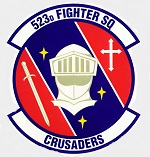Hobby Master HA3028 USAF General Dynamics F-111F Aardvark Strike Aircraft - 73-0715, 523rd Tactical Fighter Squadron "Crusaders", RAF Fairford, England, "Central Enterprise 95", 1995 (1:72 Scale)
"Tell the Vietnamese they've got to draw in their horns or we're going to bomb them back into the Stone Age. And we would shove them back into the Stone Age with Air power or Naval power - not with ground forces."
- General Curtis LeMay, May 1964
 The General Dynamics F-111 "Aardvark" is a medium-range interdictor and tactical strike aircraft that also fills the roles of strategic bomber, reconnaissance, and electronic warfare in its various versions. Developed in the 1960s and first entering service in 1967, the United States Air Force (USAF) variants were officially retired by 1998. The Royal Australian Air Force (RAAF) is the sole remaining operator of the F-111.
The General Dynamics F-111 "Aardvark" is a medium-range interdictor and tactical strike aircraft that also fills the roles of strategic bomber, reconnaissance, and electronic warfare in its various versions. Developed in the 1960s and first entering service in 1967, the United States Air Force (USAF) variants were officially retired by 1998. The Royal Australian Air Force (RAAF) is the sole remaining operator of the F-111.
The F-111 pioneered several technologies for production military aircraft including variable-sweep wings, afterburning turbofan engines, and automated terrain following radar for low-level, high-speed flight. Its design was influential, being reflected in later Soviet aircraft such as the Sukhoi Su-24, and some of its advanced features have since become commonplace. During its inception, however, the F-111 suffered a variety of development problems, and several of its intended roles, such as naval interception through the F-111B, failed to materialize.
In USAF service the F-111 has been effectively replaced by the F-15E Strike Eagle for medium-range precision strike missions, while the supersonic bomber role has been assumed by the B-1B Lancer. In 2007, the RAAF decided to replace its 21 F-111s in 2010 with 24 F/A-18F Super Hornets.
Pictured here is a 1:72 scale rendition of a USAF General Dynamics F-111F Aardvark Strike Aircraft that was attached to the 523rd Tactical Fighter Squadron "Crusaders", then deployed to RAF Fairford, England, during 1995.
Sold Out!
Dimensions:
Wingspan: 12-1/4-inches
Length: 10-1/2-inches
Release Date: September 2021
 Historical Account: "Central Enterprise" - Central Enterprise is an annual NATO live-fire exercise. Central Enterprise is designed to test the integrated air defense system throughout Western Europe. Regular exercises which incorporate a major military low flying element over the United Kingdom include Exercises Elder Forest (once every two years), Elder Joust (once a year), Central Enterprise (once a year), Mallet Blow (twice a year), OSEX (once a year) and Salty Hammer (once a year). Some of these exercises test and practice the United Kingdom air defenses while others primarily provide aircrews with training in tactical low flying techniques.
Historical Account: "Central Enterprise" - Central Enterprise is an annual NATO live-fire exercise. Central Enterprise is designed to test the integrated air defense system throughout Western Europe. Regular exercises which incorporate a major military low flying element over the United Kingdom include Exercises Elder Forest (once every two years), Elder Joust (once a year), Central Enterprise (once a year), Mallet Blow (twice a year), OSEX (once a year) and Salty Hammer (once a year). Some of these exercises test and practice the United Kingdom air defenses while others primarily provide aircrews with training in tactical low flying techniques.
The Central Enterprise exercise was designed to evaluate new joint air defense employment concepts. The exercise was a good start for NATO, though Air Force participation was initially relatively scripted in support of the Army evaluation and emphasis was on the evaluation as opposed to training.
The June 1982 Central Enterprise exercise marked the first practical test of the new NATO airborne early warning system.
During the Central Enterprise exercise held at June 1993 in Europe, eight F 117-A's were deployed at Gilzen Rijen in the Netherlands.
General characteristics - Crew: 2 (pilot and weapons system operator)
- Length: 73 ft 6 in (22.4 m)
- Wingspan:
- Spread: 63 ft (19.2 m)
- Swept: 32 ft (9.75 m)
- Height: 17.13 ft (5.22 m)
- Wing area:
- Spread: 657.4 ft (61.07 m)
- Swept: 525 ft² (48.77 m²)
- Airfoil: NACA 64-210.68 root, NACA 64-209.80 tip
- Empty weight: 47,200 lb (21,400 kg)
- Loaded weight: 82,800 lb (37,600 kg)
- Max takeoff weight: 100,000 lb (45,300 kg)
- Powerplant: 2 Pratt & Whitney TF30-P-100 turbofans
- Dry thrust: 17,900 lbf (79.6 kN) each
- Thrust with afterburner: 25,100 lbf (112 kN) each
- Zero-lift drag coefficient: 0.0186
- Drag area: 9.36 ft² (0.87 m)
- Aspect ratio: spread: 7.56, swept: 1.95
Performance - Maximum speed: Mach 2.5 (1,650 mph, 2,655 km/h)
- Combat radius: 1,330 mi (1,160 nmi, 2,140 km)
- Ferry range: 4,200 mi (3,700 nmi, 6,760 km)
- Service ceiling: 66,000 ft (20,100 m)
- Rate of climb: 25,890 ft/min (131.5 m/s)
- Wing loading:
- Spread: 126.0 lb/ft (615.2 kg/m²)
- Swept: 158 lb/ft² (771 kg/m²)
- Thrust/weight: 0.61
- Lift-to-drag ratio: 15.8
Armament - Guns: 1 M61 Vulcan 20 mm (0.787 in) gatling cannon (seldom fitted)
- Hardpoints: 9 in total (8× under-wing, 1 under-fuselage between engines)
- Armament capacity: 31,500 lb (14,300 kg) ordnance mounted externally on hardpoints and internally in fuselage weapons bay
Bombs: - Free-fall general-purpose bombs
- Mk 82 (500 lb/227 kg)
- Mk 83 (1,000 lb/454 kg)
- Mk 84 (2,000 lb/907 kg)
- Mk 117 (750 lb/340 kg)
- Cluster bombs
- BLU-109 (2,000 lb/907 kg) hardened penetration bomb
- Paveway laser-guided bombs, including:
- GBU-10 (2,000 lb/907 kg)
- GBU-12 (500 lb/227 kg)
- GBU-28, specialized 4,800 lb (2,200 kg) penetration bomb
- BLU-107 Durandal runway-cratering bomb
- GBU-15 electro-optical bomb
- AGM-130 stand-off bomb
Wingspan: 12-1/4-inches
Length: 10-1/2-inches
|


